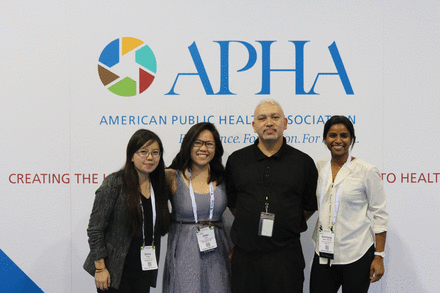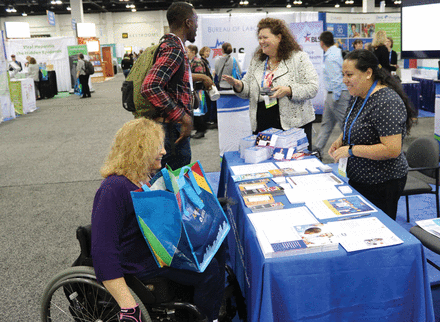In one of the nation’s healthiest states, it was with great gusto and an eye toward the future that thousands of public health professionals, educators, students and advocates came together to recommit to making health equity a reality.
For APHA’s 2016 Annual Meeting and Expo, held Oct. 29-Nov. 2 in Denver, nearly 12,000 attendees gathered to share their best work, practices and goals toward the meeting’s theme, “Creating the Healthiest Nation: Ensuring the Right to Health.” Throughout the meeting’s hundreds of scientific and poster sessions, thousands of abstracts, business meetings and career and networking opportunities over five days, covering the entirety of public health’s reach, attendees discussed the ways barriers to health can be eliminated for individuals and communities.

Annual Meeting participants discuss research on HIV prevention during one of the Denver event’s many poster sessions.
Photo by Michele Late
That so many people face issues of access can be hard to acknowledge, especially as public health leaders gathered in “a most walkable and bikeable city, with clean air and fluoridated water,” noted APHA Executive Director Georges Benjamin, MD, in his remarks at the meeting’s opening session on Oct. 30. But public health must lead the way in fighting those inequities, recognizing privilege and prejudice to rectify historical injustices against entire communities of color, Benjamin said.

Cecile Richards, president of Planned Parenthood Federation of America, talks about inequities and barriers to health care access during the Annual Meeting opening session.
Photo courtesy EZ Event Photography
“We have to acknowledge that playing field,” he told the packed auditorium in the Colorado Convention Center. “We do not live in a land of equal opportunity.”

Attendees pose for a photo at the Mix and Mingle Lounge.
Photo courtesy EZ Event Photography
Opening session keynote speaker Cecile Richards, president of Planned Parenthood Federation of America, also addressed those inequities and barriers to health care access, but highlighted the work Planned Parenthood’s 650 health centers are doing to make them a thing of the past, including improving telemedicine, offering online scheduling and education and working “especially in the tough places” to build a movement toward public health.
Richards also noted the political climate, as the Annual Meeting was held just days before the 2016 presidential election. In the face of opposition to women’s health care needs, including abortion and contraceptive care, Richards said that women’s health care must continue to be incorporated into the mainstream fight for women’s rights. She pointed out that, as Planned Parenthood celebrated its 100th anniversary, women in the U.S. live about 30 years longer than they did when the organization was founded. In the next 100 years, she said, Planned Parenthood will continue to fight for health equity, regardless of race, ethnicity, country of origin, immigration status, gender identity or sexual orientation.
“That is why we are here and working for the future we are going to build together,” Richards said. “I’ve never been prouder to be on the side of public health.”
Local leaders also spoke out during the opening session about the important role public health plays in communities. Brian Turner, MPH, president of the Colorado Public Health Association, called on attendees to be champions for social justice and to manifest change, noting “the fundamental right to health is still facing opposition at every turn.” Colorado Gov. John Hickenlooper said the state would not rest on its laurels as one of the healthiest in the nation, calling it “a good competition; we all win.” He touted the state’s two-generation approach to public health, setting kids up for healthy habits that will last a lifetime and keeping seniors active, by making sure all children live within a 10-minute walk to a park or green space, enrolling 16,000 state employees in wellness programs and making long-acting reversible contraceptives available to any Colorado woman or girl who wants them.

The APHA meeting offered numerous opportunities for education, including this Learning Institute on global health. About 450 people took part in the meeting’s two days of institutes.
Photo by Michele Late

Yoga was one of the many free attractions offered at the meeting’s Wellness Center.
Photo courtesy EZ Event Photography
At the front lines of ensuring the right to health is the Centers for Disease Control and Prevention, which has been working for 70 years to improve and protect the health of Americans. During a Monday afternoon session, past and current leaders from the agency spoke to a packed auditorium about the agency’s legacy and their experiences steering the “disease detectives of the world.”
Current CDC Director Tom Frieden, MD, MPH, shared the stage with former directors Julie Gerberding, MD, MPH; Jeffrey Koplan, MD, MPH; and David Satcher, MD, PhD, who also served as U.S. surgeon general and is an APHA member. APHA’s Benjamin asked the leaders about their work at the helm of the agency, their priorities for the nation’s health and their advice for the next president, among other health topics.
While working at CDC is a rewarding experience, being on the front lines comes with challenges, the directors said, from educating Congress to racing to save lives during infectious disease outbreaks. For Frieden, one of the most challenging parts of his term was responding to the explosive spread of Ebola in West Africa in 2014. The multi-country outbreak led to more than 11,000 deaths and as many as 28,000 cases of the disease.
“We really saw the possibility of the world on the brink of not just hundreds of thousands of deaths from Ebola, but shutting down health care systems,” Frieden said. “The challenge was, how can you move fast enough?”
CDC stepped up the challenge of responding to the outbreak, putting 1,400 people in the field in West Africa and dedicating 4,000 staff to the response, he said. Though the initial outbreak has been controlled, the agency continues to respond to flare-ups, including 13 cases in Guinea and Liberia that occurred in March.
The people who work at CDC “have a deep caring about people all over the world and are really ready to go anywhere, anytime to fight diseases and protect the health of people,” Satcher said.
Other sessions during the meeting drew big crowds, including many of the special sessions. Earlier Monday, attendees came together to hear Michael Marmot, PhD, MPH, MBBS, director of University College London’s Institute of Health Equity; Karen DeSalvo, MD, MPH, MSc, acting assistant secretary for health in the U.S. Department of Health and Human Services; and leaders from the United Kingdom’s Royal Society for Public Health discuss the ways health advocates around the globe can advance programs that promote health and address inequalities.

From left, former CDC directors David Satcher, Jeffrey Koplan and Julie Gerberding share experiences at a Monday session.
Photo courtesy EZ Event Photography
Working conditions can lead to gaps in health, said Marmot, who highlighted both physical risks and wage inequalities by gender. DeSalvo discussed Public Health 3.0, HHS’ new plan to integrate social determinants of health across the U.S. agency.
“This is our window, this is our time, this is our era of attending to social determinants of health,” DeSalvo said.
At the Nov. 2 closing session in Denver, APHA welcomed to the stage the two other names synonymous with public health in America: the Association of State and Territorial Health Officials and the National Association of County and City Health Officials. Moderated by incoming APHA President Thomas Quade, MPH, MA, health commissioner for Marion County, Ohio, the panel discussion kicked off with a definition of health equity from Camara Jones, MD, PhD, MPH, who represented APHA on the panel and was ending her term as APHA president.
Jones, a senior fellow at the Satcher Health Leadership Institute at Morehouse School of Medicine, started by saying her definition of health equity differs from the Healthy People 2020 definition, which is the “attainment of the highest level of health for all people.” Instead, Jones defined health equity as the “assurance of the conditions of optimal health for all people.” The main reason for the difference, she told hundreds of closing session attendees, is to emphasize that health equity is not an outcome, but a process — and one that requires vigilance to sustain.
A session called “Vital Directions: Prescriptions for Our Future,” hosted by former APHA President Shiriki Kumanyika, PhD, MPH, also garnered strong interest. Her session, as well as the opening, CDC and other key sessions, can be watched in full now via APHA Live. People who missed the sessions or who want to revisit them for continuing education credits can do so now online. More information on APHA Live is available at www.apha.org/apha-live.
Attendees gain health education, inspiration
For many attendees, the Annual Meeting is an opportunity for continuing education, and the 2016 meeting was no different. Nearly 1,300 registrants signed up for continuing education credits at the meeting. About 450 people registered for Learning Institutes, half-, full-or two-day sessions that explored topics in greater detail, and enhanced their Annual Meeting experiences. Institutes on evaluating public health programs, biostatistics and evidence-based health sold out.
For people who were not able to attend the Annual Meeting, or for those who missed a session or want to revisit a great one, access to the Recorded Annual Meeting Presentations program is now available. While not eligible for CE credit, RAMP allows participants to listen to audio and view slides from hundreds of scientific sessions. For more information, visit www.apha.org/ramp.
As in past years, social media enhanced the Annual Meeting experience, and brought highlights to those who could not attend. More than 20,000 tweets were shared with the #APHA2016 hashtag on Twitter, and many photos were shared under the same hashtag on Instagram. APHA’s Annual Meeting Blog included nearly 60 posts at www.publichealthnewswire.org/annualmeeting. APHA’s Storify account included daily wrap-ups of highlights and opportunities at the meeting and beyond, as a final post offered tips on how to live out the mission set forward by the Annual Meeting theme.
Record crowds attended the APHA Annual Meeting Social Media Lab, hosted by APHA and AIDS.gov. More than 60 people stopped by the two-day lab for one-on-one sessions covering everything from the basics of setting up a Twitter account to building specific social media plans. Nearly 300 people attended the lab’s theater sessions as well, which touched on Snapchat, social media editorial calendars and brand-building.
For the second year, APHA partnered with international film and broadcasting company WebsEdge to bring APHA TV news reports to attendees and viewers at home. Each day’s video productions included meeting highlights, behind-the-scenes interviews and attendees’ reactions to the day’s events. More than 25 news reports can be watched now via the 2016 Annual Meeting playlist at www.youtube.com/aphaorg.

The APHA Annual Meeting offered numerous opportunities to connect with people in public health and make new friends.
Photo by Michele Late

The U.S. Office of Minority Health’s booth was one of the 530 that attracted visitors during the Public Health Expo.
Photo by Michele Late
While in Denver, Annual Meeting attendees abided by the campsite rule — the guiding principle that urges people to leave a place better than they found it. Through APHA’s Help Us Help Them campaign, participants raised $13,000 for the Metro Denver Homeless Initiative, a collaboration of local partners that provide regional resources to prevent and end homelessness. Seventy organizations, including homeless-assistance and housing providers, local and state agencies, foundations, mental health centers, neighborhood groups and people who are homeless work together to develop a continuum of care for area residents who are homeless or at risk of becoming so.
Attendees were also able to work on their own health, in and out of the Colorado Convention Center. APHA’s second Annual Meeting dance, set to Justin Timberlake’s “Can’t Stop The Feeling!” drew a large crowd that got into the public health-inspired choreography, from hand-washing to safe driving. Video of the dance is available online now via APHA’s YouTube channel.
Another way to relive some of the magic of the Annual Meeting is by checking out the many photos of the meeting’s events. The Nation’s Health staff took hundreds of photos, now posted on APHA’s Flickr page at www.flickr.com/aphapublichealth. And EZ Event Photography took thousands more images, which are available to view online at bit.ly/APHAPics16. To order photos from EZ Event Photography, email jezell{at}usa.net or call 562-277-6292.
Planning is well underway for APHA’s 2017 Annual Meeting and Expo, which will be held Nov. 4-8 in Atlanta. This year’s Annual Meeting theme will be “Creating the Healthiest Nation: Climate Changes Health.” Members and other public health scholars and advocates are encouraged to submit abstracts, particularly on the intersection of climate change and health, for the meeting. Abstract deadlines vary, but fall between Feb. 20-24.
For more information on the APHA Annual Meeting, visit www.apha.org/annualmeeting.
Michele Late and Kim Krisberg also contributed to this report.
- Copyright The Nation’s Health, American Public Health Association









